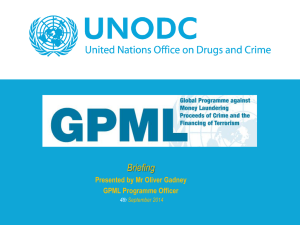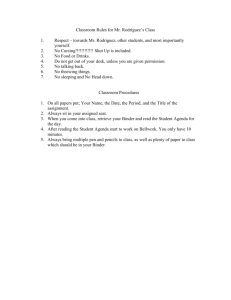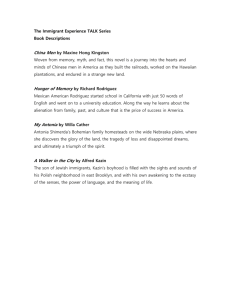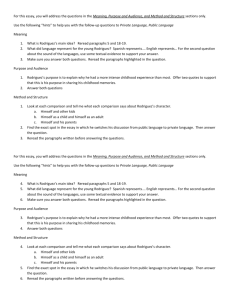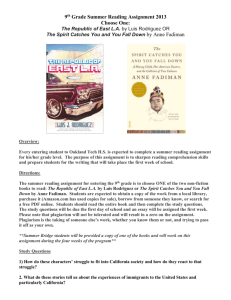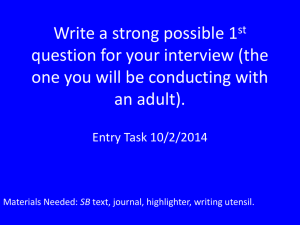Transcript - FBICover
advertisement
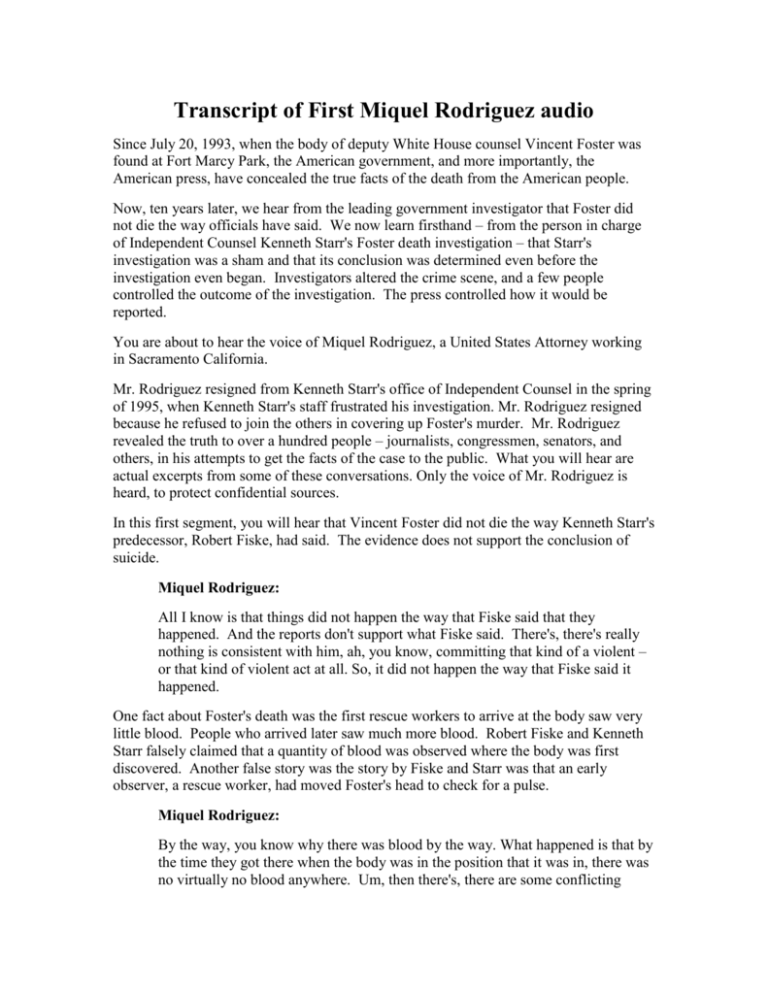
Transcript of First Miquel Rodriguez audio Since July 20, 1993, when the body of deputy White House counsel Vincent Foster was found at Fort Marcy Park, the American government, and more importantly, the American press, have concealed the true facts of the death from the American people. Now, ten years later, we hear from the leading government investigator that Foster did not die the way officials have said. We now learn firsthand – from the person in charge of Independent Counsel Kenneth Starr's Foster death investigation – that Starr's investigation was a sham and that its conclusion was determined even before the investigation even began. Investigators altered the crime scene, and a few people controlled the outcome of the investigation. The press controlled how it would be reported. You are about to hear the voice of Miquel Rodriguez, a United States Attorney working in Sacramento California. Mr. Rodriguez resigned from Kenneth Starr's office of Independent Counsel in the spring of 1995, when Kenneth Starr's staff frustrated his investigation. Mr. Rodriguez resigned because he refused to join the others in covering up Foster's murder. Mr. Rodriguez revealed the truth to over a hundred people – journalists, congressmen, senators, and others, in his attempts to get the facts of the case to the public. What you will hear are actual excerpts from some of these conversations. Only the voice of Mr. Rodriguez is heard, to protect confidential sources. In this first segment, you will hear that Vincent Foster did not die the way Kenneth Starr's predecessor, Robert Fiske, had said. The evidence does not support the conclusion of suicide. Miquel Rodriguez: All I know is that things did not happen the way that Fiske said that they happened. And the reports don't support what Fiske said. There's, there's really nothing is consistent with him, ah, you know, committing that kind of a violent – or that kind of violent act at all. So, it did not happen the way that Fiske said it happened. One fact about Foster's death was the first rescue workers to arrive at the body saw very little blood. People who arrived later saw much more blood. Robert Fiske and Kenneth Starr falsely claimed that a quantity of blood was observed where the body was first discovered. Another false story was the story by Fiske and Starr was that an early observer, a rescue worker, had moved Foster's head to check for a pulse. Miquel Rodriguez: By the way, you know why there was blood by the way. What happened is that by the time they got there when the body was in the position that it was in, there was no virtually no blood anywhere. Um, then there's, there are some conflicting reports about there being blood later on. Later the EMT sees blood, then Haut sees blood. Well the reason is very clear. They lifted the body and pulled it to the top of the ridge, top of the berm, and once they did that blood started flowing fast. And then when they took the body and put it into the body bag, which was right – in other words they – it was on a slope – they pull it up onto the slope. In fact, one of the persons who was there when the body was pulled made a joke because the body started sliding back down the hill. Then, they pulled the body up to the top of the berm. When the body is horizontal or even at the top of the berm it's not quite horizontal it's a little bit of a back-slope – and all of a sudden the blood starts gushing out, there's a lot of blood then under the body. Miquel Rodriguez explains that the body was moved in the presence of Park Police Officer John Rolla, with the knowledge of the medical examiner Dr. Donald Haut, and others. Rescue worker Corey Ashford arrived at Foster's body after it had already been moved Crime scene photos of the body as it had originally been observed apparently vanished. Miquel Rodriguez: Exactly, but Corey's also the one who – that's when the body's in the upright – not in the upright – but in the ah, in a ah, supine position, um, on the top of the berm, already, in other words, different than, some of the – Ashford and the persons who actually lifted the body into the body bag, don't see the body in its original position. They see it in a horizontal position, um, having been moved from a vertical position. And so when it's in the horizontal position there is blood coagulating under the body before it goes into the body bag. That explains the difference in there being a lot of blood. And that's what Haut sees also. Haut asks that the body be rolled, um, when it's in the horizontal position, so when Haut sees the body, the body then a horizontal state – and yes there's going to be blood. You see so Haut actually sees the body in two positions and people are conveniently using different phrases of Haut to justify whatever result they want. Sure Haut says on one hand there is no blood, then, he says, on the other hand, there is blood. The fact is, a number of people have said there was a small amount where the body was originally found. Later on it's moved to a horizontal position at the top of the berm where it does have some seepage under the body. And then when they put it in the body bag they see, faced in that horizontal position, there's a ten-inch or so bloodstain under the body. Mike Wallace of 60 minutes, and Jim Wooten of ABC News hoodwinked the public by broadcasting that there was plenty of blood where Foster's body was found. There was more tampering with the crime scene when the FBI re-landscaped the park where Foster's body was found, destroying evidence of park trails and entrances. Miquel Rodriguez: And do you really know what the egress and, and access is, ah, to the Park. You have to go back to 1993. You have to go back to prior to the body being found and find out what access there was, who knew about that access, um, and how is it changed. That is the whole point, you're, again you guys really have to understand they've re-landscaped it prior to this – you know, they, they've changed gates, they've changed paths, they've changed trees, they've filled gullies, they've redefined the slope. You know the whole thing was changed when I was there. The whole area has been re-landscaped. They've even taken, they've even filled the gorge down below – they've taken that and filled it with, with ah pieces of wood and so that they've changed the path that used to be down at the bottom of the berm. You, you guys can't imagine what the aerials looked like a year before. It is – all of this is just so much nonsense. It was landscaped the sly long ago. They, they backfilled. Officially, Foster was found with a black colt revolver in his hand. But that's not what the first witnesses saw. Richard Arthur, a paramedic at the scene saw an automatic pistol. The investigators ignored this gun. The gun officially found in Foster's hand was not the same gun in his hand when the rescue workers arrived. Miquel Rodriguez: Even the Park Police, even the Park Police and the person who first saw the body, ah, saw different things. But there was a point in time where the particular gun that he described arrived and something before that was either not observed or not completely identified. Both paramedics at the scene saw a bullet wound in Vince Foster's neck. Miquel Rodriguez reviewed photographs of the body at the scene and also saw the trauma to Fosarter's Fisk's report falsely stated that, "photographs found at the scene conclusively show that there was no such wounds." Starr's report stated that the paramedic who was saw the bullet wound in the neck ''may have been mistaken." Miquel Rodriguez: Both EMT's – you know when you have a, a murder scene you call the fire department they will send their normal crew and each crew may have an EMT with them, ah, with a specially trained fire department person. Both EMT's that responded to the Park both observed trauma to the neck. While Arthur remained clear on it despite the FBI's attempt to shake him, the other one was confused by the FBI and kept saying what he saw but they kept writing it a different way. I saw pictures that clearly indicate to me that there is trauma on the neck. I believe it's a puncture wound on the neck. Kenneth Starr's report on Foster's death states, "according to Secret Service records, the Secret Service was notified of Mr. Foster's death at about 8:30 p.m. eastern time on July 20th." Paramedics and rescue workers were called at 6:00 pm, and, according to Miquel Rodriguez, the White House knew well before the first 911 call was placed. Miquel Rodriguez: There's indications that the White House and others knew prior to the time it was officially said to be told. There was notification made well before the time that the EMTs were called. Reporters and editors have deceived people by publicizing the foolish idea that that too many people would have to be involved for the a cover-up to remain secret. Miquel Rodriguez: There's not that many people who know these things really. You don't need a lot of people to know what's going on. In fact, you don't need many at all. Everyone makes a very big mistake when they believe that a lot of people are necessary to orchestrate some kind of – some result here. Very few people need to know anything about anything, really. All, all people need to know is what their job is, not why – be a good soldier, carry out the orders. And there are a lot of people from – starting at the very night that the body was investigated, all the way down the line, there were, there were, people told to do certain things and they didn't – and there – and their rationale was that they were following orders, being told what to do. Nobody, ah, and this goes for all the FBI agents – they all, they don't necessarily know the big picture – they don't know what other people are writing in their reports. When you write a report all you have to do is make sure that it's consistent with – the most innocuous thing is to make sure it is consistent with the result that you ultimately want to get, which is not embarrass your other colleagues who have made a conclusions already. It's some motivation which is that simple and, and, you know all of a sudden your notes aren't, don't, exactly reflect what other people have said. It’s very simple. It's a very, a very, ah, clean formula to achieve the result. You don't have to know the big picture. All you need to do is just have a couple of people involved. In other words, if Braun and, you know, two or three others are out there assisting and making this all go smoothly, right, then they're the ones who ultimately collecting all the notes of the other officers, right, then they, all they do is submit their own notes and their final report. You see, very few people that they've sent people out there and you, you, ah, talk to those people, interview 'em and I'll be over in a little while. You know, you come over, you get their notes and you write your report. Your report's wrong, you hope nobody's gonna catch you on it but if they do so what. It gets obscured and obscured and obscured because you, you control the central figures in the investigation. We don't need all these Park Police and all these FBI agents to know the overall crime. The FBI conducted the first investigation along with the Park Police. The FBI reinvestigated Foster's death under Independent Counsel Fiske, then, Kenneth Starr used the very same FBI agents in his investigation for his investigation. The American press misled the American public by reporting that there have been several independent investigations, when, in fact, all of the investigations were done by the FBI .. Miquel Rodriguez: Starr could only be as good as the agents – I mean how independent can Starr really be when he was being supplied by the very same agency, ah, you know with the investigative team that did the investigation in first – the very same people. Kenneth Starr hired Dr. Henry Lee lend Lee's reputation to the cover-up.Another member of Starr's investigation was Mark Touhey, a former District of Columbia's Bar. Mark Touhey squelched Rodriguez' efforts to issue subpoenas and call witnesses. Miquel Rodriguez: I honestly believe that there's a, ah, that ah, that the reason he's hired is to guarantee a result. And Mr. Lee's, um, reputation will be used to close the door again. You know, the, the games are being played with people, you know, like, like Lee and, and, and ah, Tuohey and, and – the young aspiring people, you know, who I used to work with back in that office – who will, will say and do what they have to, to move up the ladder. It's not just Tuohey, there's a lot of people that are, are very interested in controlling the result here. I wrote that to Starr back in January of, of this year and in December of this year it was squelched by, by Tuohey because a lot of – he was a team player and, you know, I know, my office was searched by him, you know, um, I know what he is capable of doing. That includes throwing a tantrum and throwing chairs. I was unable to call witnesses and issue subpoenas and, under control of the democrat Mark Tuohey, who was compromised. It's in – it's in many Republican's interest to not rock the boat. There is – what we're talking about is ultimate power. Clearly, the American Press participated in the cover-up of Foster's murder. Miquel Rodriguez reached out and told "over 100" reporters much more than you're hearing today. The American Press only parroted the official lie that they were spoon-fed by Kenneth Starr's Office of Independent Counsel. Miquel Rodriguez: I have talked to a number of people that – you know, from Time Magazine, Newsweek, Nightline, the New York Times, Boston Globe, the Atlanta whatever, um, you know there have been well over a hundred, and it risks – this matter is so sealed tight and, um, the reporters are all genuinely interested but the ah, the ah, um, the report– the ed– reporters are genuinely interested but the ah – when they start to get excited and they've got a story and they're ready to go, the editors – and they – I've gotten calls back, I've gotten calls back from all kinds of magazines worldwide, what the hell's wrong, why can't, you know, you were telling me that you, you didn't think this would go anywhere and sure enough I wrote the stories. They went to all the trouble of writing, and then it got killed. Again, I, I, you know, I spent almost eleven hours with, with Labiton, or six hours with Labiton, and ah, you know, I know the guy knows, um, that there's a lot more, um, ah – I know, I know the New York Times has it – knows, and just won't ah, ah, I know that they won't do anything about it and I do know that, that many people have called me back. Reporters that I've spent a lot of time with called me back and said the editors won't allow it to go to press. The accepted media here has always had, ah, a certain take on all of this. And there's been story lines from the get-go. There never really was an investigation into Vincent Foster's death. There was only the appearance of an investigation. Park Police investigator Cheryl Braun, admitted in testimony that the determination that the death was a suicide was made prior to her going up and looking at the body. The Fiske and Starr investigations were result-oriented. Miquel Rodriguez resigned because he would not be part of an investigation with a forgone conclusion. Miquel Rodriguez: It's ah, the result is being dictated by a lot higher, um, authority than I think people really understand or appreciate and certainly more than I ever appreciated. What with this whole notion ah, you know, of, of doing an honest investigation, um, you know, you know, it's, it's laughable. I knew what the result was going to be, I was told what the result was going to be from the get-go. And then there's all so much fluff, and a look-good job, it's just, this is all, all so much nonsense and I knew the result before the investigation began. That's why I left. I don't do investigations like that – to do investigations to justify results. There's a – again, I don't think they can go back to the fact that, and it's just a fact for me because it was told to me, the result here has already been determined. It was determined long ago. Fiske himself indicated that he had determined the result before he had ever released a report. And that's the way all the investigations have resulted – it ends before it's ended. Again, you know, I left for a very good reason. The results, you know, were dictated and I don't do that kind of work. Who has the power to threaten the United States Attorney without consequence? Miquel Rodriguez was threatened. He was threatened professionally, physically, and personally. Miquel Rodriguez: The Independent Counsel themselves, and the FBI, beat me back, in fact threatened me. They told me to quote, this is a quote, "back off," either "back off or back down." They used both of them. You know it's – I have been communicated with again and told to you know, to be careful where I tread. I can tell you this, that ah, ah, that it has not only to do with my career and reputation, um, they’ve also had to do with my personal health and family. The Jason Blair's are only a distraction from what is wrong with the American press. The ongoing problem is the owners and editors that continue to protect the people who threatened Miquel Rodriguez. As long as the criminal cover-up of Vince Foster's murder continues, the journalism profession deserves the scorn of the American public. This audio presentation was written and produced by Whitewater grand jury witness Pat Knowlton and his lawyer John H. Clarke for the American people. Permission is granted to everyone to copy and share this audio. END
